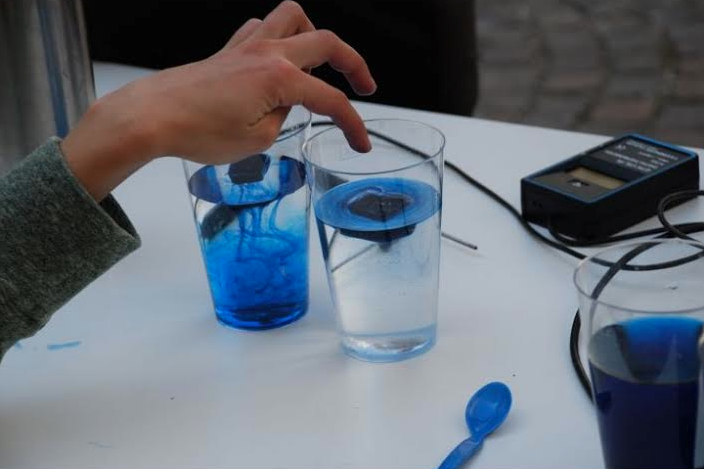
Guest post: The mystery of the cold room

Melting ice. A comparison of sea ice and glaciers melting’s impact on sea level, ice cubes melting in fresh and salt water on the right. Photo by “Forschungsschwerpunkt Alpiner Raum”, University of Innsbruck.
As we expected many groups with many students, I needed a lot of ice. I told the organizers so (“I need a lot of ice, you know, frozen water”) and they said no problem, they will turn on their cooling chamber. The day before, I went there and put tons of water into little cups and ice cube bags into the chamber to freeze over night.The next morning – some hundreds of students had already arrived and were welcomed in the courtyard – I went to get some ice for the first group. I opened the cooling chamber,… and froze instantly. Not so very much because of the cold temperature but because I was met by lots of ice cube bags and little cups with… water. Like in LIQUID WATER! Cold liquid water, yeah, but still LIQUID! Arrrghhhh, my class was about to begin in a few minutes and I had NO ICE. “Ah, yes”, volunteered the friendly caretaker, “come to think of it, it is just a cooling chamber!”I started panicking, until a colleague pointed out the Sacher Cafe (this is Austria after all) and their ice machine across the road. I never really appreciated ice machines, but that one along with the friendly staff saved the day. Luckily, I brought some colored ice cubes from at home – so I was all set to start.

Ice melting in fresh water (left) and salt water (right). Photo by “Forschungsschwerpunkt Alpiner Raum”, University of Innsbruck.
And the station was a big success, the students were all interested, asked many questions and were excited about the colored melt water sinking and not sinking. :-) I even managed to “steal” some students from the neighboring station of my dear meteorology colleagues. That was something I was particularly proud of as they could offer a weather station, lots of fun instruments to play with and a projector to show all of their fancy data on a big screen. (Actually, I also abandoned my station for a while to check out their weather balloon.)
Anyway, I had a lot of fun that day and could definitely relate to Mirjams enthusiasm for this kind of teaching. I can’t wait for the next opportunity to share some of those simple yet cool experiments with interested students. I will bring my own ice though!
Why folic acid might be good for people, but not so good for tank experiments – Mirjam S. Glessmer says:
[…] Guest post: The mystery of the cold room […]
Four steps to great hands-on outreach experiences – Mirjam S. Glessmer says:
[…] kind of “backup materials”: Bring pictures and/or movies of your experiment to show what it should have looked like in case the freezer that was supposed to have turned your ice cube tray full of water into ice […]
GeoLog | GeoEd: One example of how playing works in outreach activities! says:
[…] kind of “backup materials”: Bring pictures and/or movies of your experiment to show what it should have looked like in case the freezer that was supposed to have turned your ice cube tray full of water into ice […]
Why might students not learn from demonstrations what we want them to learn? | says:
[…] Kristin and I have been invited to lead a workshop on “Conducting oceanography experiments in a conventional classroom” at the European Marine Science Educators Association EMSEA14 conference in Gothenburg in October (and you should definitely come – it’s gonna be a great conference!). And while you know I’m a big fan of showing a lot of demonstrations and experiments in class, for the purpose of this workshop I’ve looked into the literature to base the argument for (or against) demonstrations on a sound scientific basis. […]
Melting ice cubes | Kristin Richter says:
[…] melting ice in sea water and fresh water to students and the general public. I wrote about the mystery of the cold room on my friend Mirjams blog. Check it […]
Melting ice cubes reloaded | Adventures in Oceanography and Teaching says:
[…] Guest post: The mystery of the cold room […]